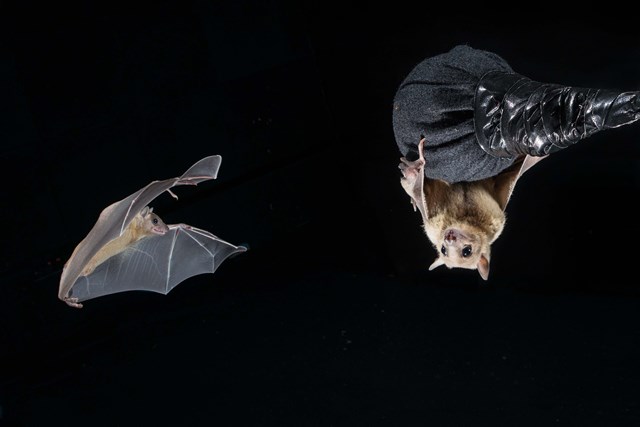Bats have helped to decipher how we map the movements of ourselves and others. Credit: Weizmann Inst. of Science.
Neural mapping system, which tells an animal where it is, also monitors the position of others.
The brain’s navigation system — which keeps track of where we are in space — also monitors the movements of others, experiments in bats and rats suggest.
In a study published in Science on 11 January, neuroscientists in Israel pinpoint individual brain cells that seem specialized to track other animals or objects. These cells occur in the same region of the brain — the hippocampus — as cells that are known to map a bat’s own location. In a second paper, scientists in Japan report finding similar brain activity when rats watched other rats moving.
The unexpected findings deepen insight into the mammalian brain’s complex navigation system. Bats and rats are social animals that, like people, need to know the locations of other members of their group so that they can interact, learn from each other and move around together.
Researchers have already discovered several different types of cell whose signals combine to tell an animal where it is: ‘place’ cells, for example, fire when animals are in a particular location, whereas other types correspond to speed or head direction, or even act as a kind of compass. The latest reports mark the first discovery of cells that are attuned to other animals, rather than the self.
“Obviously, the whereabouts of others must be encoded somewhere in the brain, but it is intriguing to see that it seems be in the same area that tracks self,” says Edvard Moser, a neuroscientist at the Kavli Institute for Systems Neuroscience in Trondheim, Norway, who shared the 2014 Nobel Prize in Physiology or Medicine for revealing elements of the navigation system.
Buddy tracker
Neurobiologist Nachum Ulanovsky and his colleagues at the Weizmann Institute of Science in Rehovot, Israel, designed their study to see what happens in a bat’s brain when it tracks the movement of another bat.
The researchers trained pairs of Egyptian fruit bats (Rousettus aegyptiacus) in a room to fly from one post to another and back, in return for a treat. Another bat — the ‘observer’ — watched the first animal, and was rewarded if it copied the same flight path. The prospect of a reward motivated the observer bat to pay close attention to the other’s trajectory.
The team also trained the observer bats to track bat-sized plastic objects that the researchers moved between the posts. The scientists implanted electrodes into the observer bats’ hippocampuses to record their brain signals.
The were not surprised to see that one subset of cells fired in response to the observer bat’s own position as it flew, indicating recognition of ‘self’ location. These were regular place cells. But they were surprised to find that another subset fired in response to the position of the other flying bat; the researchers called these social place cells. They also identified a set that responded to the inanimate plastic objects — and this group had a different activity pattern from the social place cells.
There was substantial overlap between the subsets. For example, some neurons fired in response to both the other bat and the objects, or to both the other bat and their own positions. In essence, the same part of the brain seems to track both the physical landscape and the social landscape, says Ulanovsky — but using slightly different cell populations.
“It will probably add up to an overall population code that will tell the bat which of the nearby moving animals or objects are the most important to pay attention to,” says Ulanovsky. He is planning further studies using multiple bats of different social status — for instance, dominant or subordinate, or female or male — flying together.
The rat study — led by Shigeyoshi Fujisawa at the RIKEN Brain Science Institute in Saitama, Japan, and also published in Science — made similar conclusions. As with previously identified parts of the navigation system, it's probable the phenomena extend to other mammals including humans, researchers say.
Whether social place cells are exclusively for tracking other members of the same species, or whether they are part of a system of hippocampal cells that encode all sorts of trajectories — be they those of animals or objects — isn’t yet clear, says Moser. “But in either case, it would be exciting.”

